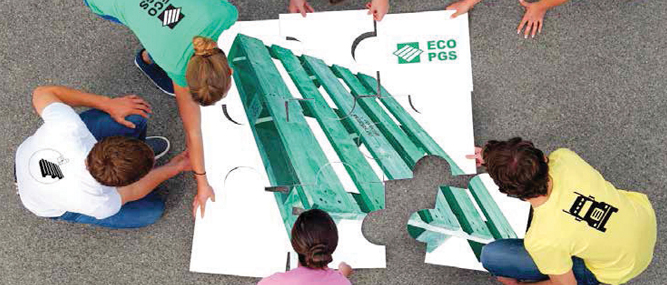What are your options in the face of timber uncertainty? The current level of concern about timber supply in the United Kingdom was underscored by a large record turnout this March at a general meeting held by the Timber Packaging & Pallet Confederation (TIMCON).
“The record numbers who attended last month’s general meeting illustrates the severity of the situation in which the timber packaging and pallet business currently finds itself,” noted John Dye, TIMCON president. “Fortunately, as a part of the wider forest-based industry, we have strong allies with whom we are sharing information and developing coordinated responses and solutions to the current challenges.”
Scott Group’s Recovery and Reuse Program
One of those long-term solutions to the current situation is pallet reuse, especially for sectors such as industrial and others where single-use pallet programs have previously been prevalent. Interest in pallet recovery, remanufacture and reuse in the UK is growing, according to Karen Hunter of Scott Group.
Scott Group is the country’s largest pallet producer. Hunter noted that while pallet pooling models are an established solution for the standard sizes found in the UK –1200×1000 or 1200×800, other pallet designs have faced barriers to reuse.
According to Hunter, Scott Pallets and HLC (Part of the Scott Group), “were quick to recognize this growing interest in circular business practice and rather than viewing it as a threat to its established pallet manufacturing business, chose to invest in the development of a national pallet recovery and reuse service to meet this shifting paradigm.”
Scott’s approach reflects the diversity of its customers’ pallet needs and supply chains. Customer collaboration is critical for this reuse approach. As Cathy Morio, Scott Pallets’ commercial manager explained, “Only by working collaboratively with our customers have we been able to develop a model that stands up environmentally and commercially.”
Customers’ own pallets are efficiently recovered from house builders, contractors, distributors, retailers and end users via a national network of logistics partners.”
Scott began its pallet recovery and reuse program in 2008, which has continued to grow. In 2017, the company recovered and reused 1.2 million pallets. One of those customer-specific reuse programs, the Green Pallet Scheme with building supply (DIY) retailer B&Q, was an award winner at Ethical Corporation’s 2016 Responsible Business Awards.
Scott Pallets and B&Q devised the Green Pallet Scheme to support B&Q’s “One Planet Home” sustainability initiative by reducing the number of single-use pallets. The global nature of the B&Q supply made the switch a challenging one to orchestrate. The Green Pallet Scheme offers returnable pallets in the required sizes and made only from responsibly sourced timber.
PGS Group: Pooling When Pallet Recovery Isn’t Always Possible
Another European company, PGS Group, based in France and with locations in 14 countries, has focused on innovative pooling offers. It now offers three branded solutions within its PGS REVERSE organization. These include ECO PGS, RLS, and REVERSE+.
ECO PGS is a pallet rental solution targeted for business-to-business rather than fast moving consumer goods. ECOGPS pallets are offered in four pallet types and two common sizes. They are painted green. Examples of customer applications include food ingredients, building products and more. Central to the PGS business model is a recognition that the company will not be able to collect 100% of the pallets because they are being shipped across Europe.
The PGS approach starts with analyzing logistical data from the customer and determining an estimated pallet loss rate. “If a customer accepts, he will pay a fixed fee no matter how many pallets we recover,” explained Michael Mudugno, vice president and founder of PGS. As a result, pressure is removed from customers and shifted onto PGS to recover the minimum amount included in their business model.
After the first year, the pricing is reviewed with the customer in a transparent process. If recovery rates exceed the original estimate, then PGS reduces the pallet movement cost. If recovery is less than projected, however, then PGS holds the price but does not raise it. “If we collected less (than the estimated amount), it’s our problem,” he said.
RLS, a second service, is dedicated to the popular EPAL/EUR and Dusseldorfer pallets. It is a pallet banking scheme that enables participants to deposit and withdraw pallets across the PGS European network, as well as offering sorting and repair services.
The third service, REVERSE+, pertains to custom retrieval programs. “We can manage any type of pallet, crates, boxes and packaging for customers,” Mudugno said.
Asked if the current lumber shortage is driving interest in PGS programs, he said, “Yes it’s obvious. It helps a lot to generate more contacts and interest for our customers for relocation of their pallets.”
To be certain, various managed pallet programs in the industrial sector have been around for decades, and others continue to emerge. The current lumber supply situation in Europe and North America, combined with growing momentum around the circular economy, is pushing the reuse concept into sectors that previously were dominated by single-use pallets. The growth in logistics capabilities, tracking technology and supply chain collaboration has changed the landscape. Even if you have evaluated the concept in the past, it might make sense to take a creative look at your single-use pallet customers. The timing might be at hand for a shift to a managed reuse solution.




